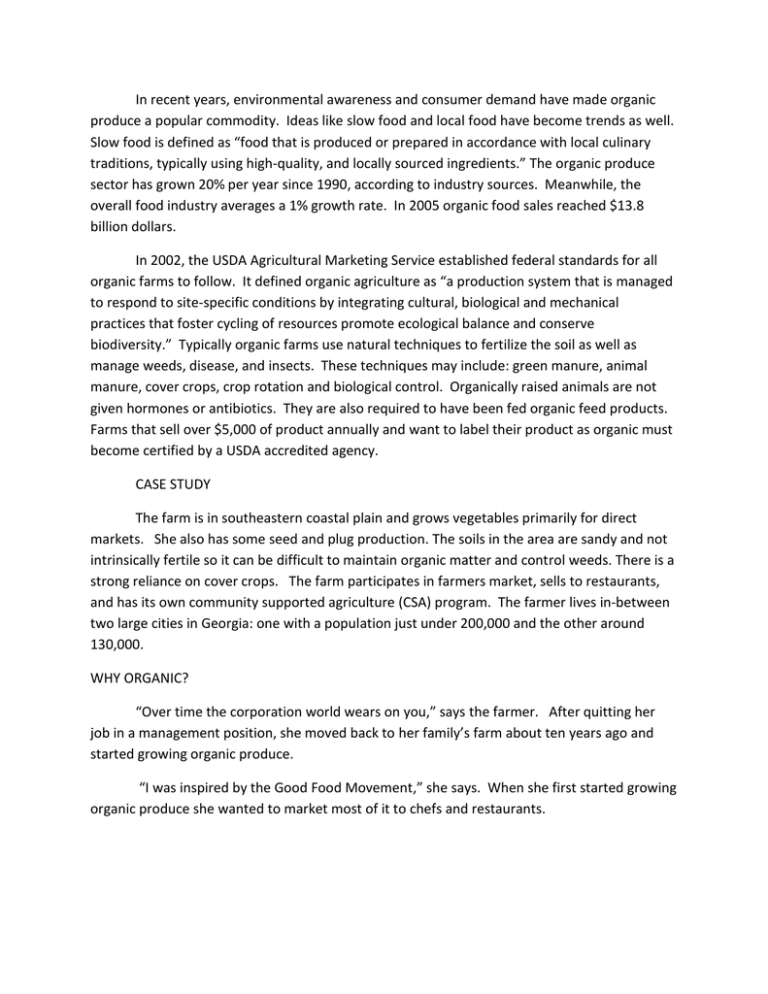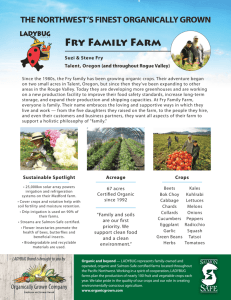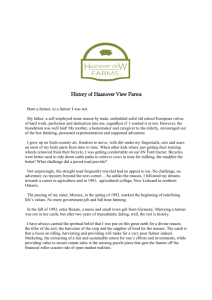In recent years, environmental awareness and consumer demand
advertisement

In recent years, environmental awareness and consumer demand have made organic produce a popular commodity. Ideas like slow food and local food have become trends as well. Slow food is defined as “food that is produced or prepared in accordance with local culinary traditions, typically using high-quality, and locally sourced ingredients.” The organic produce sector has grown 20% per year since 1990, according to industry sources. Meanwhile, the overall food industry averages a 1% growth rate. In 2005 organic food sales reached $13.8 billion dollars. In 2002, the USDA Agricultural Marketing Service established federal standards for all organic farms to follow. It defined organic agriculture as “a production system that is managed to respond to site-specific conditions by integrating cultural, biological and mechanical practices that foster cycling of resources promote ecological balance and conserve biodiversity.” Typically organic farms use natural techniques to fertilize the soil as well as manage weeds, disease, and insects. These techniques may include: green manure, animal manure, cover crops, crop rotation and biological control. Organically raised animals are not given hormones or antibiotics. They are also required to have been fed organic feed products. Farms that sell over $5,000 of product annually and want to label their product as organic must become certified by a USDA accredited agency. CASE STUDY The farm is in southeastern coastal plain and grows vegetables primarily for direct markets. She also has some seed and plug production. The soils in the area are sandy and not intrinsically fertile so it can be difficult to maintain organic matter and control weeds. There is a strong reliance on cover crops. The farm participates in farmers market, sells to restaurants, and has its own community supported agriculture (CSA) program. The farmer lives in-between two large cities in Georgia: one with a population just under 200,000 and the other around 130,000. WHY ORGANIC? “Over time the corporation world wears on you,” says the farmer. After quitting her job in a management position, she moved back to her family’s farm about ten years ago and started growing organic produce. “I was inspired by the Good Food Movement,” she says. When she first started growing organic produce she wanted to market most of it to chefs and restaurants. CROPS PRODUCED The farm includes a broad array of vegetables including carrots, onions, greens, and beets. In addition to vegetables, they grow melons and herbs. She also has a hoop house which she utilizes during the winter months. Carrots, onions, potatoes and salad greens are the most profitable to her business. She looks forward to expanding her crops in the near future with broccoli, cabbage, and cauliflower. While most of the produce that is harvested is not able to be stored for very long, she does store onions and potatoes until they are taken to the farmers market. “We are very focused on conservation issues…we are very into protecting and nurturing the land” The farm houses a low pressure sprinkler system, as well as keeping a diversity of crops and as many “good” bugs as possible. The farm used to include a piece of land that was in the Conservation Reserve Program. While the contract on the CRP has expired, the land still remains as it was and is not used for growing produce. Cover crops are a very important part to growing organic produce. They help build soil health and prevent soil erosion. At the farm every field gets a cover crop, but they are not picked out in a systematic way. Different cover crops the farmer has used include: different legumes, clover, Austrian winter peas, southern peas, buckwheat, and millet. She does not use a fixed rotation when changing these cover crops. The farmer says that sometimes cover crops can work against you. She has noticed that some cover crops attract pests more than others. In addition to using cover crops to help prevent soil erosion, the farmer also uses them for soil fertility. Two to three acres of her land get an intensive layer of compost mulch every year. She also uses poultry litter on some crops as well. A mixture of feather mill or blood mill is included in the poultry litter. After using compost mulch or poultry as a base, she includes different additives that the soil needs based on a soil test. The farmer uses the same techniques when applying fertilizer, but each crop differs slightly depending on their specific needs. As her soils and skills have grown, the farmer has learned that when it comes to fertilization you should focus on what each specific crops needs instead of using the same fertilizer on every crop. The farmer has a fairly diverse variety of crops. She grows about 40 different varieties of crops. While she has no refined regime when it comes to beneficial biodiversity, she uses different cover crops and mixed herbs or flowers to promote a beneficial habitat. When it comes to equipment, the farmer says her best piece of equipment is her John Deere tractor. In addition to her tractor, she also uses a turning plow and a tractor driven tiller occasionally. She uses a standard cultivator when it comes to cultivation. She has a homemade seeder that is pulled by a tractor, but also does some hand seeding and uses a single row seeder. Bigger crops are seeded using a John Deere seeder. Crops are harvested in one of many ways. Some crops must be hand harvested. Others can be harvested using an all crop harvester. Onions, for example, begin with a tractor driven tiller for bed preparation, then they are hand seeded, and finally they are harvested with an under cutter or by hand. In the beginning of production, she was only using a couple of acres of her 67 certified and cultivatable land. Nowadays she has about 10 acres of vegetables and 10-20 acres of cover or seed crops. Over time she has expanded greatly, but now she is trying to cut back her extensive production. “I was feeling too stretched,” she says. She is trying to find a balance between a manageable and profitable size. The farmer has a set sprinkler system over ten acres. The system focuses on most of the vegetables and some seedlings. She also has used a pivot in the past, but has greatly minimized use of it recently. Another irrigation tactic she uses occasionally is a traveling sprinkler. She would not be successful without irrigation, but over time her water use has declined. To maximize food safety, the farmer enforces a number of practices. Produce is brought directly out of the field and washed immediately. They are then dried in a spin cycle or on a wire table. She enforces that all surfaces, bins, and baskets are washed and cleaned after each use. When packing produce for markets new bags and boxes are used to eliminate contamination. The farm also includes a high tunnel production with one high tunnel currently. The high tunnel is used during the winter months or when the weather is more questionable. She hasn’t has much success with the high tunnel, but she accounts this to not working at it hard enough yet. Arugula and lettuces have been the most successful crops grown in the high tunnels. Others have not been total failures, but just less successful. One example of less successful crops the farm has encountered is tomatoes. MARKETS There are many different markets available to small farms. Farmers markets create a direct market for these farms. They are usually open April through December and are open one to two days, depending on the specific market. Many small farmers also sell to local restaurants that emphasize local foods. Community supported agriculture programs are also a market available to small farmers. These programs often include signing up for a membership. A membership includes a box of seasonal produce each week. Farms either have a set box of produce or give members an option of what they would like included in their share. Websites like locallygrown.net make it easy for farmers to set up an online CSA program where members can make payments and box selections online. The wholesale market is also an option for small farmers. With the new emphasis on local food, the farmer has formed business relationships with several chefs who buy produce every week based on seasonal availability and supply. In one case, the farmer has an open order for 60 lbs. per week of an “entrée vegetable,” which is based on her discretion. Additionally, this same chef has a standing order for additional produce that might seem unique or special. While restaurants have been a reliable and satisfactory component of the farm’s diversified markets, there are also drawbacks. She has found that restaurants are not always a good source of financial stability. Some chefs say that they will buy everything she can grow of a certain crop. The farmer says that chefs don’t realize how much that can actually be produced. Chefs also get bored with current fads and move on to new ones rapidly. Without a contract or agreement, this can create problems. Many farmers markets were just getting started in the cities around her when she first began farming organically. While building the demand for local produce, these markets would get started and close very soon afterwards. Three years ago they started to become permanent in the areas surrounding her. She now uses these farmers markets as her main form of income. She says now that she has found her primary revenue source, her main task is to supply the right product and the right amount of product for the demand. Customer service has been a big key to being successful. She builds strong relationships with customers and interacts with them by suggesting cooking methods and different recipes. Having a good product helps this relationship as well. With a product that appeals to the eyes and the taste buds, she has increased her customer base. “If it doesn’t taste good, we don’t send it to market,” she says. The farm also has a money back guarantee on their products. Word of mouth, social media, and a newsletter are the marketing tools that the farm uses. By posting pictures of the produce available at market on the farm’s Facebook page, customers are able to decide what they will buy before they get to the stand. “Many people come to the stand having seen what is on Facebook. That way they know what we have and don’t buy it at another stand before they get to us,” she says. These products can also be found in the newsletter. The newsletter gives a quick run-down of what is going on at the farm as well. FARM MANAGEMENT “When I started this endeavor I pictured myself sitting in the winter, reading my seed catalogs, but that is not the case with an eleven month growing season.” She has found that the farm is very labor-intensive and time consuming year-round. “Labor was the stone that sank me,” the farmer says. This is where most expenses came from, but in recent years she has cut back. In addition to part-time workers, she has started an internship program on the farm. “Labor is the most difficult problem…the internship has been a big help,” she said, “It is hard to control weeds and do the cultivating. This is all hand work.” The interns help with hoeing and pulling weeds, as well as cultivating. They are also key to harvesting, coordinating harvests and a packing for online markets, restaurants, and farmers markets. Each intern brings their own style and personality to the Saturday markets. The farmer advertises the internships through the farm website, World Wide Opportunities on Organic Farms (wwoof.net), and Attra, the National Sustainable Agriculture Information Service website. She selects interns based on a questionnaire that includes not only questions on farming experience but on each applicant’s lifestyle. Interns must stay at least three months, but many stay as long as one year. She wants them to learn and experience different seasons on the farm. Disadvantages to having interns on the farm include: the turnover rate, young people often need more management, and occasionally drama between interns. She says that more than half want to become farmers while others want to learn about farming and where food comes from. Interns work and live on the farm. A place to live, food, and access to internet are all included in the internship. The internship also includes a small stipend. She hires a bookkeeper to keep her records in order. Currently, she is the sole farm manager, but she would consider hiring a full-time farm manager if she found the right person. The farm is under a general liability policy through the Farm Bureau. This policy just covers labor on the farm. There are currently no required hazard plans, but the farmer has attended food safety programs put on by her local county extension agent. These programs have raised consciousness about hand and food washing, as well as the controls that need to be improved on the farm. The farm does not currently have written protocols, but it is a wish of the farmer to establish some soon. “GAP (Good Agricultural Practices) is very elaborate for a farm this size, but I would be willing to participate in some sort of certification,” she stated. FARM ECONOMICS The farmer spends around 47% of her expenses on labor. In addition to this she spends around 8% on seeds and plant purchases, 7% on car and truck expenses, 6% on fertility and seed amendments, 6% on utilities, and 26% on other items such as fuel, organic certification, office supplies, taxes, marketing expenses, and others. Organic Farm--Expenses Utilities Fertility and Seed 6% Amendments 6% Other 26% Labor 47% Car and Truck Expenses 7% Seeds and Plants Purchases 8% Most of the farm’s income (79%) for the farm comes from produce sales. The remaining forms of income are seed sales (10%), other crop sales (7%), and other, including flower sales, consulting, and agricultural program payments (4%). Organic Farm--Income Other Crop Sales 7% Seed Sales 10% Other 4% Produce Sales 79% LESSONS LEARNED “When people ask me what I would do different I always say that I would start it out with a serious business plan, instead of piddling around” she says. “I don’t have all the solutions, but I don’t mind sharing.” The farmer has found solutions to labor problems, but still has some obstacles to face. She would like to come up with enterprise budgets for the farm. In addition she would like to find some help to address tackling other enterprise decisions.





